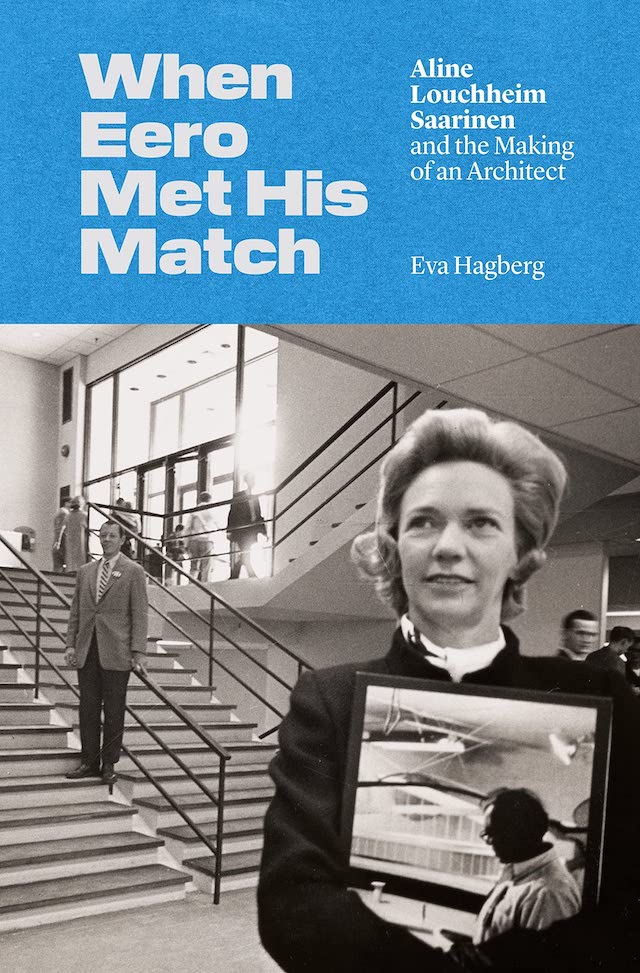When Eero Met His Match
When Eero Met His Match: Aline Louchheim Saarinen and the Making of an Architectby Eva HagbergPrinceton University Press, September 2022Hardcover | 6-1/4 x 9-1/2 inches | 232 pages | 35 illustrations | English | ISBN: 9780691206677 | $33PUBLISHER'S DESCRIPTION:Aline B. Louchheim (1914–1972) was an art critic on assignment for the New York Times in 1953 when she first met the Finnish-American architect Eero Saarinen. She would become his wife and the driving force behind his rise to critical prominence. When Eero Met His Match draws on the couple’s personal correspondence to reconstruct the early days of their thrilling courtship and traces Louchheim’s gradual takeover of Saarinen’s public narrative in the 1950s, the decade when his career soared to unprecedented heights.Drawing on her own experiences as an architecture journalist on the receiving end of press pitches and then as a secret publicist for high-end architects, Eva Hagberg paints an unforgettable portrait of Louchheim while revealing the inner workings of a media world that has always relied on secrecy, friendship, and the exchange of favors. She describes how Louchheim codified the practices of architectural publicity that have become widely adopted today, and shows how, without Louchheim as his wife and publicist, Saarinen’s work would not have been nearly as well known.Providing a new understanding of postwar architectural history in the United States, When Eero Met His Match is both a poignant love story and a superb biographical study that challenges us to reconsider the relationship between fame and media representation, and the ways the narratives of others can become our own.Eva Hagberg teaches in the Language and Thinking Program at Bard College and at the Graduate School of Architecture, Planning, and Preservation at Columbia University. Her books include How to Be Loved: A Memoir of Lifesaving Friendship and Nature Framed: At Home in the Landscape. She lives in Brooklyn.REFERRAL LINKS: REVIEW:When I started working on what would become Buildings in Print: 100 Influential and Inspiring Illustrated Architecture Books, I knew one of the chapters would be devoted to monographs, but I did not know that Eero Saarinen at Work would be one of them. I was unaware of the monograph at the time, but when I did learn about it during the short making of my book, I was so intrigued by it's timing (the year after Saarinen's death in 1961 at the age of just 51) and the fact it was edited by his second wife, Aline B. Saarinen, that it felt necessary to include. Born Bernstein and with the Louchheim surname by marriage, Aline was an editor at the New York Times when they met in 1953; one year later she married Eero and moved from New York to suburban Detroit to direct the public relations at the famed architect's office. As Head of Information Services at Eero Saarinen and Associates, Aline controlled how the firm's work was presented and shaped Eero's public image, both of which continued the after his death, when a number of projects were on the drawing boards or under construction. The monograph she edited — basically the first on Eero — was an integral part of this continuation, which I touched up on in my description of the book in Buildings in Print. Eva Hagberg's excellent book on Aline's role in Eero's personal life and work life adds considerably to what I knew about their relationship, which was gleaned from articles such as Alexandra Lange's piece "Love and Architecture" at Design Observer and Kornel Ringli's Designing TWA book. Hagberg, a critic and one-time "secret high-end publicist," uses When Eero Met His Match to correct the diminished role attributed to Aline in Eero's career, as portrayed in articles at the time but also in monographs published decades later. "Correct" might not be the right word though, since even though Aline was often described simply as "his wife" in contemporary publications, and she was barely mentioned in historical monographs that presented Eero as a master architect in the vein of Mies and Corbu, her hidden, behind-the-scenes presence was intentional as much as it was the product of its male-dominated time. Quoting extensively from the archives of the Aline and Eero Saarinen Papers at the Smithsonian, Hagberg repeats the now-familiar refrain that Aline saw Eero as an architect first and person second, but digs further to reveal how Aline basically created the position in his studio for herself as they were courting, later crafted storylines for the projects (think of TWA as a "bird in flight"), and worked with editors at magazines to get the best exposure for Eero, among many other things.Anyone who has read Hagberg's articles at Architect or Curbed or elsewhere knows how she inserts herself into critiques, often recounting stories that seem marginal to the building or landscape at hand but actually tap into the subjectivity of architectural criticism — and, more importantly, the subjectivity of experiencing

by Eva Hagberg
Princeton University Press, September 2022
Hardcover | 6-1/4 x 9-1/2 inches | 232 pages | 35 illustrations | English | ISBN: 9780691206677 | $33
PUBLISHER'S DESCRIPTION:
REFERRAL LINKS:
FOR FURTHER READING:
- "Now Saarinen the Son; A modern architect, following his distinguished father's profession, comes of age in his designs for our industrial era" by Aline B. Louchheim (New York Times, 1953)
- Eero Saarinen on His Work: A Selection of Buildings Dating from 1947 to 1964 with Statements by the Architect edited by Aline B. Saarinen (Yale University Press, 1962)
- Eero Saarinen by Jayne Merkel (Phaidon, 2005)
- Eero Saarinen: Shaping the Future edited by Donald Albrecht and Eeva-Liisa Pelkonen (Yale University Press, 2006)
- "Love & Architecture" by Alexandra Lange (Design Observer, 2009)
- "Forgiving My Dad" (PDF link) by Eric Saarinen (Scandinavian Review, 2016)
- Designing TWA: Eero Saarinen’s Airport Terminal in New York by Kornel Ringli (Park Books, 2018)





